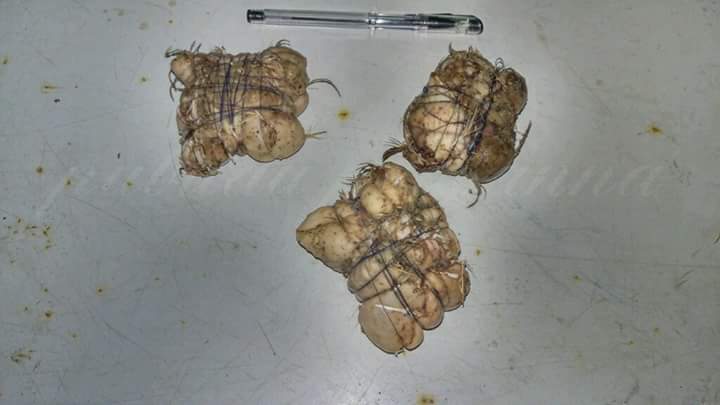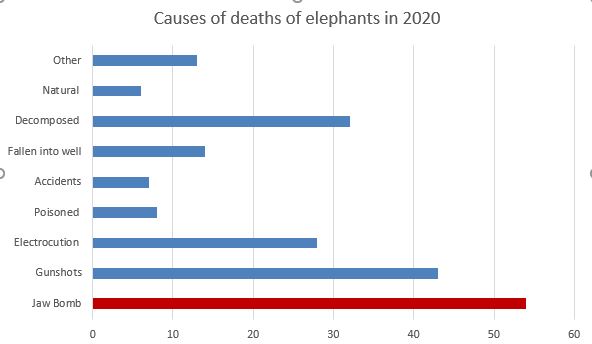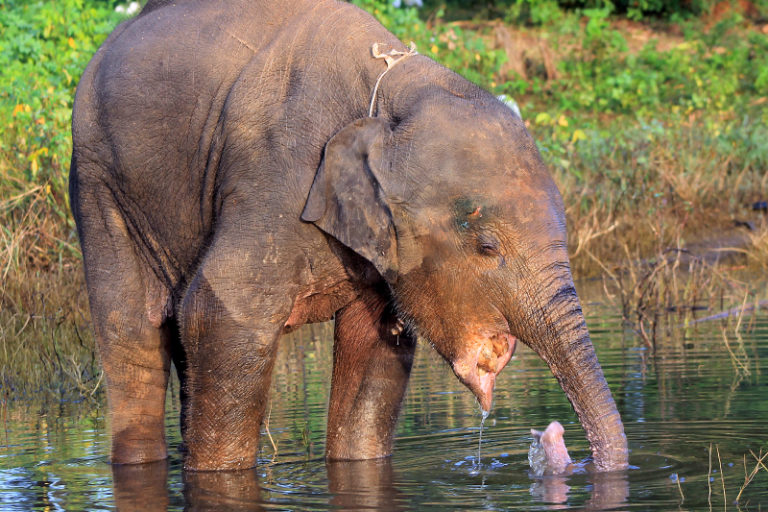by Malaka Rodrigo on 19 November 2021
- Hakka patas, an improvised explosive device that detonates when bit, is the number one killer of elephants in Sri Lanka.
- The first reports of these “jaw bombs” emerged in 2008, and although the main target of poachers is wild boars, there have been an increasing number of instances where elephants are targeted.
- The jaw bombs are made by the hunters themselves from widely available supplies and sold to farmers at the village level, making it difficult to crack down on the practice.
- With Sri Lanka’s fireworks industry suffering massive job losses under the COVID-19 pandemic, experts are warning of a possible increase in skilled workers turning to make hakka patas.
WASGAMUWA, Sri Lanka — Elephant calves arriving at dusk to drink at the Weheragala reservoir tank in Wasgamuwa National Park can be particularly playful. But one day in September 2020, a lonely young elephant was spotted exhibiting uneasy behavior. After all the other members of its herd had gone back to the wilderness to retire for the night, this calf remained in the water. It appeared exhausted, and a closer inspection revealed why: its mouth had been severely mutilated, with saliva coming out of the swollen wounds. Unable to eat or drink, the calf died the next day.
This young elephant was yet another victim of “jaw bombs” — an improvised explosive device concealed in fodder bait that detonates when bitten. Its local name is hakka patas: jaw exploder.
Hakka patas are typically targeted at wild boars and other wildlife for bushmeat, which they kill instantly. Elephants are much bigger, so while the explosives don’t kill them right away, they inflict gruesome mouth injuries and a long-drawn-out death from infection or starvation.
The first reported cases of Sri Lankan elephants (Elephas maximus maximus) killed by hakka patas came in 2008. A decade later, these explosives have become the number one killer of this endangered species. Sri Lanka has consistently recorded more than 200 elephant killings a year for the past three years, one of the highest rates per capita of any country with a wild elephant population.

Easy-to-make explosives
The elephant calf at the Weheragala reservoir last year was the first reported case of a hakka patas being used in Wasgamuwa National Park, an ostensibly protected area. So the Sri Lanka Wildlife Conservation Society (SLWCS), an NGO that works closely with villagers to help minimize human-elephant conflict, sought to explore a little more this now-dominant threat to the country’s elephants.
“We conducted covert investigations and found that some farmers have started to use this horrible method of killing animals since June and July of 2020” said Ravi Corea, founder and president of the SLWCS.
Corea and his team tried to identify the perpetrators and raise awareness among villagers to discourage them from resorting to this inhumane method of dealing with elephants. But over the course of the next year, more elephants fell victim to the jaw bombs, showing an increase in the use of the explosive bait.
Hakka patas are easy to make. Gunpowder is mixed with gravel and metal scraps that serve as the shrapnel, and the mixture is tightly packed together. It’s then balled up with fodder and left in areas frequented by animals.
“As the trade in wild boar meat has become a huge business in some of the villages around Wasgamuwa, it also has become the most common meat consumed by villagers” Corea told Mongabay.
Corea learned through SLWCS’s local network that the explosive baits are manufactured by just a few people in the area, who sell them for around 1,500 rupees ($7.50) apiece.
Pop pop crackers, the kind that explode when thrown against a hard surface, provide the ideal ingredient that make jaw exploders work, says SLWSC researcher Chandima Fernando. In Sri Lanka, firecrackers are mainly used in April for the traditional Sinhala-Hindu New Year celebrations take place, and villagers typically keep a few packets on hand throughout the year to shoo away crop-raiding elephants and other wildlife.
But the widespread availability of pop pop crackers now means it’s easy for anyone in the community to make jaw bombs, Fernando said.

The hunters
“Villagers know who the hunters in the area are and who sets the jaw bombs,” says Deepani Jayantha, a community worker from the Hambegamuwa community near Udawalawe National Park, a known hotspot for poachers. The community was struck by tragedy in 2016 when a 10-year-old boy was killed when a hakka patas that he found while playing exploded.
The hotspot for hakka patas use against elephants appears to be Anuradhapura in Sri Lanka’s North Central province, along with parts of Eastern province. The Galgamuwa region in Anuradhapura is particularly famous for its dense elephant population. Susantha Punchi Banda, not his real name, is known within the community here for his ability to make potent jaw exploders.
“I’ve been hunting using this method for nearly 10 years” Banda told Mongabay. “I set up jaw bombs inside the forest patch at the edge of the village and collect the victims later. After making the explosives, we cover it with dried fish particles and this draws the wild boars. There are instances that other animals also bite on these explosives, including the occasional jackal.”
Banda said he was not aware of any elephants taking his bait, “but I have seen a number of elephants suffering due to biting on jaw bombs set up by others, as our village is full of hunters like me.”
He added, “I feel sorry for the elephants as they do not die instantly like other animals, but it is the fate of the beast.”
Banda used to hunt wildlife with a gun, before a colleague taught him how to make hakka patas, a method he found much easier for hunting.
“It is dangerous and if the device gets unnecessarily crushed, it can prove disastrous,” Banda said, recalling an instance when one of his colleagues lost fingers while trying to make a jaw exploder.
“It is not hard to learn, but I do not teach others. Those who hunt know how to make it, but farmers come to buy jaw exploders from me to protect their crop,” he said.
Banda also said that some farmers deliberately target elephants with jaw bombs, often out of a vengeful response from extensive damage to their crops or home. The bait of choice when targeting elephants is a pumpkin, he added.

Source of explosives
Hakka patas only get attention when elephant deaths are reported, but plenty of other wildlife fall victim to these explosives, largely unnoticed, according to veterinary surgeons at the Department of Wildlife Conservation (DWC).
Due to the widespread use of hakka patas, some environmentalists say it’s possible the jaw bombs are being manufactured for commercial purposes centrally and distributed throughout Sri Lanka through a covert network, though there’s no evidence yet to substantiate this allegation.
What is known is that hakka patas are made by a handful of people at the local level and sold on order, which means the industry could be considered a commercial enterprise at the local level, Corea said.
If they were manufactured in factories and sold covertly through secret networks, then these factories would most likely be linked to fireworks manufacturers or people who work for them, given the need for a reliable supply of gunpowder.
For now, there’s no evidence of any such practice.
But conservationists warn that with the COVID-19 pandemic bringing the fireworks industry to a grinding halt, it’s possible that job losses in the industry might push some people to transfer their skills into producing jaw exploders. The risk is always there, they warn, which underscores the need for better surveillance.
Banner image of a young elephant, the first reported victim of a jaw bomb in Wasgamuwa National Park, a protected area, courtesy of Chandima Fernando.
This story was produced as part of a journalism fellowship under CIR’s ‘Stories from the Margins” initiative supported by the Earth Journalism Network (EJN) and Internews. It was originally published in Mongabay.




